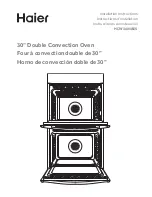
23
Function
Glass
Py
rex
Pyr
oceram
Terracotta
Aluminium
foil
Plastic
Paper or car
dboar
d
Metal
containers
Microwave
Defrost
Steam
(certain models only)
YES
YES
YES
YES
NO
YES
YES
NO
Mic Grill
Mic Fan
Pizza
Breakfast
NO
YES
YES
YES
NO
NO
NO
NO
Grill
Fan
Spit roast
(certain models only)
NO
YES
YES
YES
YES
NO
NO
YES
RULES AND TIPS FOR USING THE OVEN
Microwaves are a form of electromagnetic radiation. They occur
in nature in the form of light waves (e.g. sunlight). In the oven,
these waves penetrate food from all directions to heat water, fat
and sugar molecules.
Heat is quickly generated in the food itself, while the container
warms up as a result of heat spreading from the food only.
In microwave cooking, food does not stick to the dish. You can
therefore use very little fat and in some cases no fat at all.
As microwave cooking is low fat, microwave prepared food is
considered to be very healthy.
Microwave cooking also involves lower temperatures than tradi-
tional cooking. It therefore dehydrates foods less, destroys less
of their nutritional value and retains more original flavour.
Fundamental rules for correct microwave cooking
• Cooking time depends directly on the size and evenness of
the food. A casserole will cook faster than a roast because it
consists of smaller regular-sized pieces. When you refer to
the cooking tables later in this manual, remember that you
must increase or reduce cooking time to match the volume
of food you are cooking.
Always respect standing time, in other words, the length of
time you must leave food to “rest” after cooking. Standing
time ensures that food is served at an even temperature
throughout.
The temperature of meat, for example, can rise between
5°C and 8°C during standing time.
Food can be left to stand inside or outside the oven.
OVENWARE
In the Microwave Only and Combi with Microwave functions,
any glass (preferably Pyrex), ceramic, china or terracotta
ovenware may be used provided it has no metal decorations or
parts (e.g. gold decorations, metal handles, feet etc.).
Heat resistant plastic plates can also be used, but only for “Mi-
crowave Only” cooking.
If you are in doubt as to the suitability of a particular container,
carry out this simple test - place the empty container in the oven
for 60 seconds at maximum power (“Microwave Only” function).
If the container remains cold or heats up only slightly, it is suita-
ble for microwave cooking. If it becomes very hot (or sparks are
produced), the container is not suitable.
When heating up for brief periods, paper napkins, cardboard
trays or disposable plastic plates can be used as a base.
The size and shape of containers must allow them to rotate ea-
sily inside the oven.
Metal, wood, cane and crystal glass containers are not suitable
for microwave cooking.
Remember that the microwaves heat the food not the ovenwa-
re. Food can therefore be cooked directly on the serving plate,
thus avoiding using and cleaning saucepans.
Always use oven mitts as the very hot food may transmit heat
to the plate.
If the oven is set to Grill, Fan or Spit Roast, all types of ovenware
can be used.
The following table provides useful guidelines for choosing
ovenware:






























